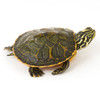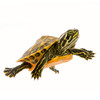Product Description
Overview:
The Florida Red-Bellied Turtle is a medium to large freshwater species native to the ponds, lakes, and rivers of Florida and southern Georgia. Known for their vibrant red or orange plastron (belly) and active nature, these turtles make fantastic animals for keepers with space for their needs. They are hardy, social, and enjoy swimming and basking.
Quick Facts:
- Size: Males 8-10 inches; females 10-14 inches.
- Lifespan: 25-40+ years with proper care.
- Temperament: Generally peaceful; can coexist with other turtles of similar size and temperament.
- Activity Level: Highly active swimmers and frequent baskers.
- Diet: Primarily herbivorous as adults, but juveniles require more protein.
Fun Facts:
- Florida Red-Bellied Turtles often lay their eggs in alligator nests in the wild, using the gator’s protection to keep predators away.
- They are strong swimmers and enjoy exploring large aquatic environments.
- Their vibrant red or orange plastron gives them their striking name.
B Grade Turtles may have minor imperfections or defects that make them less desirable than A Grade Turtles. These issues can include shell imperfections, nipped tails, missing nails, missing eyes, or missing feet (forefoot or hindfoot), among others. Because of these conditions, they are sold at a discounted price.
Please note that B Grade Turtles are not eligible for our Arrive Alive or 7-Day Health guarantees.

















